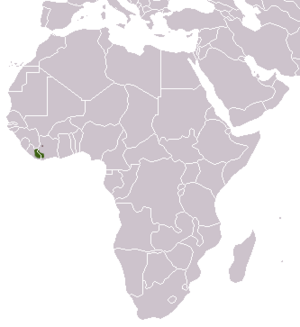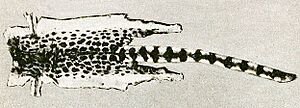West African oyan facts for kids
Quick facts for kids West African oyan |
|
|---|---|
| Conservation status | |
| Scientific classification | |
 |
|
| Distribution of Leighton's linsang | |
| Synonyms | |
|
Poiana richardsoni leightoni (protonym) |
The West African oyan (Poiana leightoni) is a small, cat-like animal. It lives in the deep forests of West Africa. People also call it the West African linsang. This animal is quite mysterious. Not many people have seen it in the wild. It is one of the least known small meat-eating animals in Africa.
Contents
Meet the West African Oyan
The West African oyan has a long, slim body. It has a pointy nose and a long head. Its fur is usually yellowish or reddish-brown. It has cool dark spots on its neck, back, and legs. But its tummy and chest are lighter and don't have spots.
Its long tail has about 10 to 12 dark rings, like stripes! The oyan's body is about 30–38 cm (12–15 in) long. Its tail is even longer, about 35–40 cm (14–16 in).
Where Oyans Live
The West African oyan lives high up in the trees. It prefers the top layers, called the canopy, of tropical forests. These forests are found in West Africa.
Scientists have seen oyans in the Ivory Coast. These sightings were in the 1960s and 1970s. In Liberia, oyans were recorded in many places. This was between the 1960s and the late 1980s. It is not certain if they live in Sierra Leone and Guinea.
Why Oyans Are in Danger
The West African oyan faces some big problems. One main threat is habitat loss. This happens when their forest homes are cut down. People cut down trees for logging. This means the oyans have fewer places to live and find food.
Another problem is hunting. People sometimes hunt these animals for bushmeat. This is meat from wild animals. Both logging and hunting make it harder for oyans to survive.
How the Oyan Got Its Name
The West African oyan was first described by a scientist named Reginald Innes Pocock. He wrote about it in 1907. He studied an animal that was found in Liberia.
At first, Pocock thought it was a type of Central African oyan. He gave it the name Poiana richardsoni leightoni. Later, in 1974, another scientist named Donovan Reginald Rosevear decided that "Leighton's linsang" was a unique species on its own. So, it got its own special name, Poiana leightoni.



